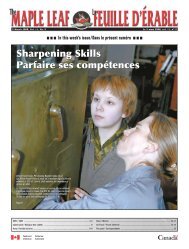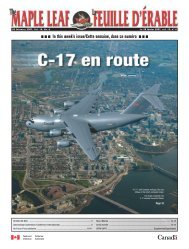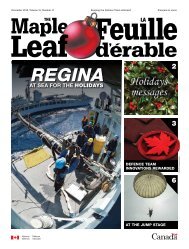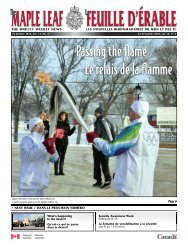Télécharger l'édition complète (version PDF, 2792k)
Télécharger l'édition complète (version PDF, 2792k)
Télécharger l'édition complète (version PDF, 2792k)
You also want an ePaper? Increase the reach of your titles
YUMPU automatically turns print PDFs into web optimized ePapers that Google loves.
Army Editor/Rédacteur en chef de l’Armée de terre • Conrad Tittley • (613) 946-4547 • Tittley.c@forces.gc.ca • www.army.gc.ca • www.armee.gc.ca<br />
By Sgt Evan Cundal<br />
10<br />
Safeguarding, sharing CF traditions, heritage<br />
A dedicated group of employees works<br />
for the Directorate of History and<br />
Heritage (DHH).<br />
“Without DHH, there would be no one<br />
to ensure that the history and traditions<br />
of the military will carry on,” says Chief<br />
Petty Officer, 1st Class Bob Horan, a<br />
driving force behind the group.<br />
Covering many aspects of military life,<br />
DHH 3, is the sub-unit responsible for<br />
CF customs and traditions. It includes<br />
colours, badges and casualty identification.<br />
Creating, repairing colours<br />
“A request for new colours is a lengthy<br />
process that can sometimes take as long as<br />
four years,” says Sergeant Daniel Rogers.<br />
He has the daunting task of overseeing<br />
the colour officer in the creation of new<br />
or the repair of existing unit colours.<br />
“We inspect every thread, making certain<br />
it is exact.”<br />
DHH must go through the unit files to<br />
ensure exact colours and threads are<br />
used, as well as the correct dimensions,<br />
names and battle honours. A contractor<br />
is then given all the materials to create<br />
the new flags, ensuring everything is<br />
done properly.<br />
Forensic anthropologist identifies<br />
remains<br />
DHH also has a forensic anthropologist<br />
on staff. Laurel Clegg manages casualty<br />
The Seaforth Highlanders’ new colours are stored at<br />
DHH until consecrated and given back to the unit during<br />
a ceremony.<br />
Les nouvelles couleurs des Seaforth Highlanders<br />
demeureront entreposées à la DHP jusqu’à ce qu’elles<br />
soient consacrées et qu’on les remette à l’unité pendant<br />
une cérémonie.<br />
DHH identified the remains of Pte Ralph Tupper<br />
Ferns, 25, who served with The Royal Regiment of<br />
Canada, Royal Canadian Infantry Corps. Pte Ferns was<br />
born in County Tipperary, Ireland.<br />
La DHP a identifié les restes du Soldat Ralph<br />
Tupper Ferns, âgé de 25 ans à sa mort, qui faisait<br />
partie du Royal Regiment of Canada, Corps d’infanterie<br />
royal canadien. Le Sdt Ferns était originaire du<br />
comté de Tipperary, en Irlande.<br />
recognition primarily for CF personnel<br />
who died before 1970. About 28 000<br />
Canadian soldiers have no known grave;<br />
20 000 of those served during the First<br />
World War. These remains are usually<br />
discovered as cities expand onto old<br />
battlefields in Germany, Belgium or France.<br />
“It is our job to confirm the remains<br />
are Canadian,” explains Ms. Clegg. “We try<br />
to identify them through badges, DNA<br />
and dental records, if possible.”<br />
DHH staff work with Veterans<br />
Affairs Canada and relatives are notified.<br />
The remains are then interred in a<br />
Commonwealth cemetery with a military<br />
ceremony if the family wishes.<br />
Private Ralph Ferns<br />
In April, DHH determined through<br />
historical, anthropological and dental<br />
evidence that remains found at Haut<br />
Mesnil, France, in March 2005 were those<br />
of Private Ralph Ferns of Toronto.<br />
Pte Ferns, a member of the Royal<br />
Regiment of Canada, was killed in the<br />
battle of the Falaise Gap in August 1944,<br />
two months after D-Day.<br />
Members of his family attended a funeral<br />
service for Pte Ferns November 14, at<br />
Couvicourt Church in France. He was<br />
buried at Bretteville-sur-Laize Canadian<br />
War Cemetery.<br />
Visit the Directorate of History and<br />
Heritage Web site at www.forces.gc.ca/<br />
dhh/.<br />
Les traditions et le patrimoine des FC à cœur<br />
Par le Sgt Evan Cundal<br />
Un groupe d’employés dévoués travaille<br />
à la Direction – Histoire et Patrimoine<br />
(DHP).<br />
« Sans la DHP, personne ne veillerait à la<br />
transmission de l’histoire et des traditions<br />
militaires », a confié le Premier maître de<br />
1 re classe Bob Horan, meneur du groupe.<br />
À titre de sous-unité chargée de<br />
plusieurs aspects de la vie militaire, la DHP<br />
3 s’occupe des coutumes et des traditions<br />
des FC, y compris les drapeaux consacrés,<br />
les insignes et l’identification des morts.<br />
Créer de nouveaux drapeaux<br />
consacrés et remmailler<br />
les anciens<br />
« Créer un nouveau drapeau consacré est<br />
un processus qui peut prendre jusqu’à<br />
quatre ans », a affirmé le Sergent Daniel<br />
Rogers. C’est à lui que revient la tâche<br />
imposante de superviser l’officier du<br />
drapeau lors du remmaillage ou de la<br />
création d’un nouveau drapeau consacré<br />
d’unité. « Nous vérifions chaque fil afin<br />
d’être sûrs qu’il est à sa place. »<br />
La DHP doit se reporter aux dossiers<br />
de l’unité afin de s’assurer qu’on emploie<br />
les couleurs et les fils nécessaires, et que<br />
les dimensions, les noms et les inscriptions<br />
au drapeau soient exacts. On fait ensuite<br />
SGT EVAN CUNDAL<br />
appel à un entrepreneur, qui confectionne<br />
le nouveau drapeau en veillant à ce que le<br />
tout soit fait selon les règles de l’art.<br />
On identifie les restes d’un soldat<br />
grâce à l’anthropologie judiciaire<br />
La DHP compte également un<br />
anthropologue judiciaire à son effectif.<br />
Laurel Clegg gère l’identification des<br />
militaires canadiens morts avant 1970; près<br />
de 28 000 de ces soldats ont participé à la<br />
Première Guerre mondiale. On découvre<br />
souvent les restes lorsque les villes<br />
s’étendent jusqu’à d’anciens champs de<br />
bataille en Allemagne, en Belgique et en<br />
France. « Notre travail consiste à identifier<br />
les corps de Canadiens. Nous tentons<br />
de les identifier à l’aide des insignes, au<br />
moyen de tests d’ADN et en consultant<br />
les fiches dentaires si possible », a expliqué<br />
Mme Clegg.<br />
On communique avec les parents des<br />
soldats morts par l’entremise du ministère<br />
des Anciens Combattants, puis les corps<br />
sont enterrés dans un cimetière du<br />
Commonwealth à l’occasion d’une cérémonie<br />
militaire, si les familles le souhaitent.<br />
Le cas du Soldat Ralph Ferns<br />
En avril 2008, la DHP a établi que les<br />
éléments de preuve historiques, anthropologiques<br />
et dentaires montraient que<br />
les restes humains trouvés à Haut Mesnil,<br />
en mars 2005, étaient ceux du Soldat<br />
Ralph Ferns.<br />
Le Sdt Ferns, qui faisait partie du<br />
Royal Regiment of Canada, a perdu la vie<br />
pendant la bataille de la brèche de Falaise<br />
en août 1944, deux mois après le jour J.<br />
Le 14 novembre 2008, les funérailles<br />
du Sdt Ferns ont eu lieu à l’église de<br />
Cauvicourt, en France. On a inhumé le<br />
corps du soldat au cimetière de guerre<br />
canadien à Bretteville-sur-Laize. Quelques<br />
membres de la famille du Sdt Ferns ont<br />
assisté aux cérémonies.<br />
Pour en savoir plus, visitez le site Web<br />
de la Direction – Histoire et Patrimoine,<br />
au www.forces.gc.ca/dhh/frgraph/<br />
home_f.asp.<br />
COURTESY OF THE FERNS FAMILY/OFFERTE PAR LA FAMILLE FERNS<br />
December 3 décembre 2008






